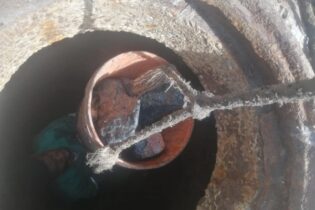The Bethlehem hydro project obtained the first, non-consumptive, water-use licence for a hydro power station under the Water Act. Water&Sanitation Africa looks at the highlights of this groundbreaking project.
The Bethlehem hydro is a truly unique venture as it is the first privately owned commercial hydropower project undertaken in South Africa in 22 years. It involved the construction of two hydropower stations on the Ash River near Lesotho at two separate sites Merino (3.6 MW) and Sol Plaatje (2.5MW). Sol Plaatje power station was commissioned in July/August 2009 and Merino Power Station in April 2010. The project uses the continuous flow being transferred from the Lesotho Mountains into the Ash River, as part of the Lesotho Highlands Water Project, to generate approximately 6.1 MW of clean, renewable electricity, which is being sold to the Dihlabeng Municipality and Eskom. BackgroundThe project was first identified in 1999. The developer, Nu Planet, obtained a grant from the Dutch government for the financing of the project’s feasibility study. In 2002, Aurecon undertook the feasibility study, which indicated that the viability of the project would be dependent on securing carbon credit funding that could be procured from European companies. Following the findings of the feasibility study, Bethlehem Hydro was created as a special-purpose vehicle to develop the project and the necessary licence applications were prepared, including environmental, generation and water-use licences. Development of the project started in 2006.
The Merino site
The Merino site is located approximately 10 km downstream of the Lesotho Highlands Water Project Delivery Tunnel outfall on the Ash River. An 8 m-high mass concrete weir diverts water to a diversion canal. The weir is designed with a 5 m-high, 60 m-long, horseshoe shaped spillway structure. A 3.2 m freeboard is provided to pass a 1:200 year flood without any overtopping. On the left bank, a soil embankment is compacted against a 7 m-high retaining wall. Along the right bank, an 8 m-high, mass-gravity structure provides for abstraction of water through three isolating sluice gates, each 2.1 m high x 1.5 m wide, operated by manual actuators.
The spillway of the diversion weir consists of a ‘typical’ mass gravity structure, but reversed, with the vertical face on the downstream side. This was found to reduce the tail water depth significantly when compared to the conventional configuration, and eliminates potential submergence problems. Splitters were provided to aerate the nappe. A 500 mm-thick structural concrete apron absorbs the impact of the nappe and minimises the risk of undermining the spillway structure. Two 150 mm-diameter pipes through the diversion wall provide the 50 ℓ/s release required by the water-use licence for the section of the river being diverted.
From the intake structure, the first 30 m of the canal is lined by concrete and is followed by 550 m of unlined canal excavated through sandstone. A low section of the canal route was first filled in with a wide saddle embankment built from clayey material and then excavated to form part of the canal. Towards the end of the canal, the natural ground level drops off and a wall was constructed to maintain the required water level in the canal. In case of a sudden power station shut down, a reject spillway has been constructed, equipped with a prototype active spillway gate, which is self-actuated by a rise in the water level. The gate is hinged and counter weights maintain the operating water level. Once stable operating conditions in the canal are restored, the counter weights automatically close the gate. The floor of the forebay slopes down to reach the invert level of the inlet to the turbine, which is approximately 20 m below the top water level. A rock trap and a fine screen have been installed in front of the inlet to prevent damage to the turbine. The inlet to the power station is protected by an emergency gate, which automatically closes upon a loss in load, preventing the generator from running away. The tailrace channel is relatively short and the power station is equipped with maintenance gates to allow for dewatering and inspection of the waterway. The internal power station dimensions are 22m x 6.6 m, which accommodates the inlet, the runner chamber and the generator floor. The draft tube dips underneath the generator floor before exiting into the tailrace channel. A 35 t gantry crane was provided for the assembly of the plant. The power station also has a control room, a switchgear room and a storage room for spare parts and tools required for the daily maintenance of the plant. Hot air from the generator is extracted through ducting at a flow rate of 7.5 m3/s. Dewatering pumps have been provided, one in the sump underneath the runner chamber and the other to drain the tailrace. The total head available at Merino is 14.8 m, while the turbine will allow a maximum flow rate of 29 m3/s, generating a maximum of 3.6 MW. The estimated annual power generation will be 24.8 GWh. The power station is located adjacent to an existing wetland, which was preserved and subject to strict environment monitoring during the construction phase.
Eskom provided a 16.4 km-long transmission line, which interconnects at the node substation to feed into the national grid. Power from the Merino Power Station will be purchased by Eskom, which means that all the electrical components and protection settings had to comply with Eskom standards.
The Sol Plaatje site
The site is located on the right bank of the existing Sol Plaatje Dam. The dam was constructed by the Department of Water Affairs in the late 1970s and the spillway works were upgraded in the 1990s, as the dam was being undermined. Since the Lesotho Highlands Water Project, the additional flow into the Ash River keeps the dam full and spilling continuously. With this project, the overflowing water is now diverted through a turbine and the power station operates in a manner that prevents the dam from spilling, while keeping the water level at its maximum. During the initial phase of the feasibility study, the power station was proposed for the left bank; however, this was changed to accommodate the length of the Kaplan turbine and for cost and constructability reasons. The power station was built behind the existing mass gravity wall, which acted as a protection for the works. A bulkhead wall was first built 1 m downstream of the existing wall and was equipped with similar isolating sluice gates to the Merino diversion weir. Once constructed, this allowed for the demolition of the mass gravity wall and the opening up of the headrace channel. A dolerite intrusion intersects the valley at the location of the bulkhead wall, which required careful excavation and anchoring of the wall deep into the weathered dolerite. The bulkhead wall is followed by a forebay, which required the construction of a box-type conduit to avoid high retaining walls. A fine screen was provided to protect the turbine. During the excavation of the power station, poor founding conditions necessitated re-siting the power station approximately 2 m upstream to obtain better founding conditions and maximise the keying in of the power station into the rock. It was not possible to key the Sol Plaatje Power Station to the same extent as Merino, and long galvanised anchors were required to counter the effect of floatation on the power station. Access during construction was difficult owing to the soft nature of the material immediately downstream of the power station. For the same reason, the tailrace is quite wide as the material is soft and required flat slopes for stability reasons. The excavation process was further complicated by a constant inflow of water into the excavation pit owing to seepage from the downstream coffer dam.
The power station structure is essentially identical to that of Merino, with access to the power station and some of the rooms mirrored. The same gates and dewatering system have been provided as for Merino. The total head available at Sol Plaatje is 10.2 m while the turbine will allow a maximum flow rate of 29 m3/s, generating a maximum of 2.5 MW. The estimated annual power generation at Merino is 18.7 GWh. A 3.4 km overhead line and a 1.1 km underground cable transmit the power from Sol Plaatje to the Dihlabeng Municipality’s Panorama Substation. Aurecon acted as the approved professional person in terms of the current dam safety regulations, as the works included the alteration to a Category III Dam. Fact box:
The Bethlehem Hydro project:
• created more than 130 job opportunities during the three years of construction
• created over 28 000 days of employment for the locals inhabitants of Dihlabeng Municipality during the construction period
• provided more than R6.5 million to local suppliers and subcontractors. Fact box:
The Bethlehem Hydro project was the first project to have obtained:
• a generation licence under new legislation in South Africa
• a non-consumptive water-use licence for a privately owned hydropower generation facility
• an environmental approval for the development of a run-of-river hydropower scheme.







